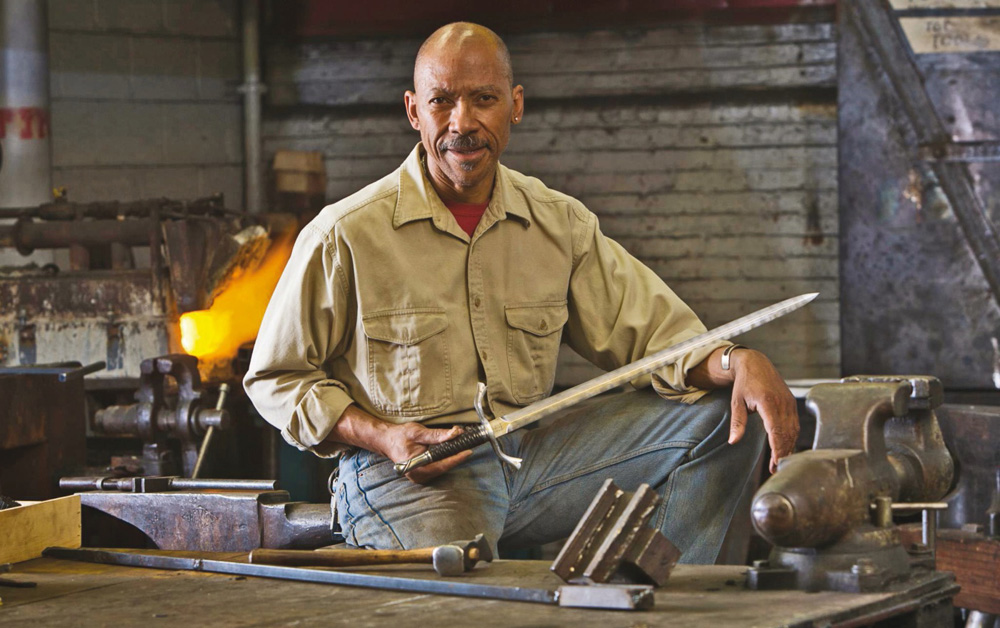- A personal approach and style.
- An object of art or music should give you a sense of life, an idea what it’s like to be in the artist’s shoes.
- Technical control.
- An endless flow of ideas.
J.D. Smith: Dancing in the Shop
J.D. Smith and I were neighbors for three years and, as it was a short walk, would frequently wander down to the Massachusetts College of Art and Design (MassArt) together, sometimes for class, sometimes just to work.
Boston’s a very diverse city, and it wasn’t uncommon for him to stop and start speaking Russian or Spanish with various friends along the way before getting to class and beginning to speak Korean with a student.
Neither was it unusual for J.D. to dance around the shop, especially while making damascus. Dance, music, sculpture: They all have a flow to them, and some people simply love to incorporate and live with all three. J.D. dances through the music, the work, and the awards. I was with him at the 2013 Oregon Knife Show when I watched him win four awards, and his study at home was littered with many more.
Two of the pieces were collaborations: one a hunting knife with now American Bladesmith Society master smith (MS) and past apprentice Zack Jonas, the second a precious metal and stone-laden sword crafted with the talented Joseph Shnayder, J.D.’s partner at AmeRRuss Blade Arts.
It was also at the Oregon show that BLADE Magazine Cutlery Hall-Of-Fame® member Wayne Goddard gifted J.D. his MS stamp, something I don’t think J.D. will ever forget.
J.D. received the MS stamp in 1998, along the way winning the B.R. Hughes Award for the best knife submitted by an MS applicant at the BLADE Show. This made J.D. the first black MS, though he tries not to dwell on this because he feels it detracts from the bladesmithing.
“The field should be blind to age, sex, and race,” he noted. “The focus should be on the work.”
Developing A Style
In 1991, J.D. walked into Joe Wood’s office, who at the time was head of the MassArt sculpture department. J.D. told Joe that the school’s officials couldn’t say they were teaching the most up-to-date metals program without teaching damascus. Joe agreed and offered J.D. a guest teaching position. In 1996, George Greenimire offered J.D. a regular class to teach.
As a teacher, J.D. would encourage students to do what he thought they were naturally inclined to do without controlling their sense of design, or discouraging them from pushing their limits. The goal isn’t to replicate other people’s work, but, if you can understand what you’re attracted to, you will have an easier time designing your own work and, hopefully, developing your own style.
“If there’s a table with 500 different knives on it,” he observed, “someone should be able to pick out your work with ease.”
When I asked him how he started to develop his style, he mentioned it being “cobbled together from Don Fogg, Wayne Goddard, Jimmy Fikes, and Wayne Valachovic—Valachovic especially for folders—Bill McHenry and Jim Schmidt.”
Bill and J.D. had become good friends over the years, and J.D. credits much of his knowledge of folders to him. Bill passed away in 2019 and is greatly missed by many inside and outside the knifemaking community.
Knifemaking: ABS Master Smith J.D. Smith’s 4 Principles of Superior Art
Over the years, J.D. has developed his Four Principles of Superior Art:
- A personal approach and style.
- An object of art or music should give you a sense of life, an idea what it’s like to be in the artist’s shoes.
- Technical control.
- An endless flow of ideas.
Further explaining his sense of style, he said, “Style is every technique that you use as part of your personal toolbox, and the things you choose not to use. That equals your style. As an artist progresses, he starts to limit his options. It shows a level of maturity. You use four or five techniques, and you develop your style off the permeation of those techniques.”
BLADE’s annual Knife Guide Issue features the newest knives and sharpeners, plus knife and axe reviews, knife sheaths, kit knives and a Knife Industry Directory.Get your FREE digital PDF instant download of the annual Knife Guide. No, really! We will email it to you right now when you subscribe to the BLADE email newsletter.
Click Here to Subscribe and get your free digital 2024 Knife Guide!
